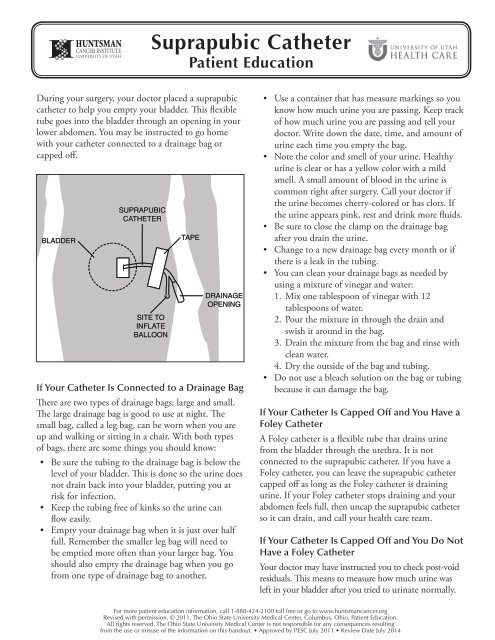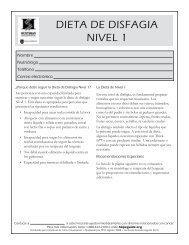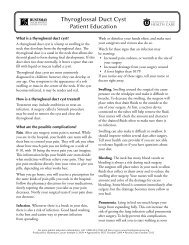Suprapubic Catheter
Suprapubic Catheter
Suprapubic Catheter
- No tags were found...
You also want an ePaper? Increase the reach of your titles
YUMPU automatically turns print PDFs into web optimized ePapers that Google loves.
<strong>Suprapubic</strong> <strong>Catheter</strong>Patient EducationDuring your surgery, your doctor placed a suprapubiccatheter to help you empty your bladder. This flexibletube goes into the bladder through an opening in yourlower abdomen. You may be instructed to go homewith your catheter connected to a drainage bag orcapped off.BLADDERSUPRAPUBICCATHETERSITE TOINFLATEBALLOONTAPEDRAINAGEOPENINGIf Your <strong>Catheter</strong> Is Connected to a Drainage BagThere are two types of drainage bags: large and small.The large drainage bag is good to use at night. Thesmall bag, called a leg bag, can be worn when you areup and walking or sitting in a chair. With both typesof bags, there are some things you should know:• Be sure the tubing to the drainage bag is below thelevel of your bladder. This is done so the urine doesnot drain back into your bladder, putting you atrisk for infection.• Keep the tubing free of kinks so the urine canflow easily.• Empty your drainage bag when it is just over halffull. Remember the smaller leg bag will need tobe emptied more often than your larger bag. Youshould also empty the drainage bag when you gofrom one type of drainage bag to another.• Use a container that has measure markings so youknow how much urine you are passing. Keep trackof how much urine you are passing and tell yourdoctor. Write down the date, time, and amount ofurine each time you empty the bag.• Note the color and smell of your urine. Healthyurine is clear or has a yellow color with a mildsmell. A small amount of blood in the urine iscommon right after surgery. Call your doctor ifthe urine becomes cherry‐colored or has clots. Ifthe urine appears pink, rest and drink more fluids.• Be sure to close the clamp on the drainage bagafter you drain the urine.• Change to a new drainage bag every month or ifthere is a leak in the tubing.• You can clean your drainage bags as needed byusing a mixture of vinegar and water:1. Mix one tablespoon of vinegar with 12tablespoons of water.2. Pour the mixture in through the drain andswish it around in the bag.3. Drain the mixture from the bag and rinse withclean water.4. Dry the outside of the bag and tubing.• Do not use a bleach solution on the bag or tubingbecause it can damage the bag.If Your <strong>Catheter</strong> Is Capped Off and You Have aFoley <strong>Catheter</strong>A Foley catheter is a flexible tube that drains urinefrom the bladder through the urethra. It is notconnected to the suprapubic catheter. If you have aFoley catheter, you can leave the suprapubic cathetercapped off as long as the Foley catheter is drainingurine. If your Foley catheter stops draining and yourabdomen feels full, then uncap the suprapubic catheterso it can drain, and call your health care team.If Your <strong>Catheter</strong> Is Capped Off and You Do NotHave a Foley <strong>Catheter</strong>Your doctor may have instructed you to check post-voidresiduals. This means to measure how much urine wasleft in your bladder after you tried to urinate normally.For more patient education information, call 1-888-424-2100 toll free or go to www.huntsmancancer.orgRevised with permission. © 2011, The Ohio State University Medical Center, Columbus, Ohio, Patient Education.All rights reserved. The Ohio State University Medical Center is not responsible for any consequences resultingfrom the use or misuse of the information on this handout. • Approved by PESC July 2011 • Review Date July 2014
Here is how to check the post‐void residual:1. Drink plenty of fluids to allow the bladder to fill.When you feel the urge to urinate, go to thebathroom and try to urinate as normally aspossible. If you have trouble feeling when yourbladder is full, urinate every three to four hoursduring the day. You may sleep through the nightunless your full bladder wakes you.2. Try to pass urine normally into a container.3. Measure the amount of urine in the container.4. Unclamp your catheter and drain it intothe container.5. Measure the amount of urine.6. Clamp your catheter.7. Write down the amount of urine you passednormally and the amount from your catheter onyour record sheet. A sample table is shown here:Date2/24TimeAmounturinatedAmountfrom tubeTotal10 a.m. 90 50 1401 p.m. 100 80 180Over time, the amount of urine from your catheter willdecrease and the amount of urine you pass normallywill increase.Caring for Your <strong>Suprapubic</strong> <strong>Catheter</strong>Change the dressing once a day by following the stepslisted below. Change it again if the dressing falls off,becomes dirty, or gets wet.1. Wash your hands with warm water and soap for atleast 15 seconds. Rinse with water and towel dry.2. Gather your supplies (all can be bought at yourlocal pharmacy or grocery store):• Plastic trash bag• Cotton applicator (Q-tip or cotton ball)• Adhesive tape• Hydrogen peroxide• Split 4 x 4 gauze dressing or drain sponge3. Take off the old dressing, being careful not to pullon the tube. Check the dressing for any unusual orfoul drainage. Throw the old dressing away.4. Wash your hands again.5. Look carefully at where the tube leaves the skin(exit site). Check for any unusual or bad-smellingdrainage, swelling, bleeding, redness, orskin irritation.6. Wash around the site gently with soap and water.You may take a shower with the tube. It will nothurt it to get wet.7. Apply hydrogen peroxide to the cottonapplicator and use it to clean any crustinessaround the catheter that does not come off withthe soap and water. Start at the place where thetube comes out of the skin and clean outwardthree to four inches in a circular motion. Neverclean back towards the tube. Let the area dry.Cotton Applicator8. Place the split 4 x 4 dressing around the tube.Tape it in place.9. Secure the catheter to the skin with adhesive tapeso it cannot be pulled off.Call your health care team if you experienceany of the following:• Urine that is cloudy, red, or has a foul odor or clots• A temperature of 101°F or higher• Redness, pain, or pus-like drainage around tube• Bladder pain or feeling of fullness• Urine leaking around the tube or no urine drainage• The catheter falls outClinic phone number:<strong>Catheter</strong> Tube321<strong>Catheter</strong> TubeCATHETERTUBE4x44X4 GAUZEGauzeDRESSINGDressing<strong>Suprapubic</strong> <strong>Catheter</strong> Patient Education - Page 2
















